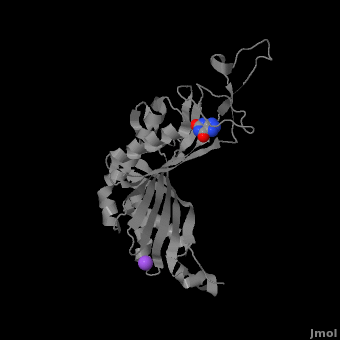Introduction
Urate oxidase or uricase or uric acid degradation bifunctional protein is an enzyme belonging to the purine degradation pathway, whose function is to prevent build-up of uric acid by catalyzing the oxidation of uric acid by molecular oxygen, leading to the production of 5-hydroxyisourate and hydrogen peroxide.[1] The catalytic mechanism of urate oxidase is unique because it does not require a cofactor or metal ion.[1] This enzyme is found in many organisms, but not in higher apes and humans. It has been suggested that this may be an evolutionary advantage, as uric acid is a strong anti-oxidant.[1] The presence of uric acid therefore results in fewer free radicals and fewer instances of cancer as a result of aging.[1] The lack of urate oxidase does, however, result in elevated levels of uric acid in the plasma, which can be fatal. Urate oxidase was first isolated from the fungus Aspergillus flavus, but is expressed in Saccharomyces cerevisiae for research and medical purposes.[1]. See also Uricase (Urate Oxidase).
Structure
The complete functional structure of urate oxidase is a 135-kDa barrel-shaped homo-tetramer that has a height of 7 nm, with an inner radius of 0.6 nm and an outer radius of 3 nm.[2][3] It has four identical active sites that are found at dimeric interfaces formed between the monomers and a central void tunnel of unknown function that is 5 nm long and has a diameter of 1.2 nm.[2] Each monomer, formed by 301 amino acid residues, has two structurally equivalent domains, which Colloc'h et al. termed “tunneling fold” domains (this feature allows urate oxidase to be placed in the expanding family of tunnel-shaped proteins that also includes 3i2b and 1a9c).[2] These domains are comprised of a four-strand long antiparallel beta sheet with two helices on the concave side. Together, the two tunneling fold domains of each monomer form an eight-strand long antiparallel beta sheet, where all four helices are found on the concave side of the sheet. The dimer forms an α8β16 barrel, in which the eight helices make up the outer surface of the barrel.[2]
Within the active site, two residues, and , are responsible for hydrogen-binding the substrate (uric acid).[1] Approximately 0.33 nm above the ligand, Asn 254 and Thr 57* (* indicates a residue from a different subunit), hydrogen-bond the molecular oxygen and the catalytic water molecule, depending on the step of the reaction.[1] The catalytic water molecule and the γ oxygen of Thr 57* are the beginning of a proton transfer chain that also involves Lys 10*, His 256 and two other water molceules, ending at N9 of uric acid.[1]
- . Water molecules are shown as red spheres.
Function
Urate oxidase has the function of preventing uric acid levels from becoming too high in certain organisms, including bacteria, yeast, fungi and some mammals.[3] In mammals, urate oxidase is found in the peroxisomes of liver hepatocytes.[4] Although this enzyme has been found in many organisms, it is absent in higher apes and humans (in the human genome this is a result of a nonsense mutation in the codon for Arg 176).[4]
Although the exact mechanism by which urate oxidase carries out its function is yet unknown, most studies agree that the catalytic proton transfer previously described is involved.[1] After compiling data from multiple studies, Gabison et al. came up with a plausible mechanism. This mechanism involves sequential addition of molecular oxygen and a water molecule to the same catalytic site, known as the peroxo site (formed by the side chains of Asn 254 and Thr 57*), resulting in a mechanism with four intermediates leading up to the product 5-hydroxyisourate.[1] As other studies have previously proposed, Gabison et al. also suggest that after uric acid binds to the enzyme, a urate [N3-, N7-] dianion is formed.[1] This step is followed by the binding of molecular oxygen, leading to the production of a 5-hydroperoxyisourate intermediate.[1] Elimination of hydrogen peroxide from 5-hydroperoxyisourate then occurs, forming dehydrourate.[1] The final step of this reaction mechanism is the addition of a hydroxyl group derived from the catalytic water molecule to dehydrourate, followed by protonation, to give the product, 5-hydroxyisourate.[1] Protonation occurs via the proton transfer chain previously described.[1]
Medical Implications
In some patients with leukemia and lymphoma, chemotherapy causes the development of a condition known as tumor lysis syndrome (a complication of hyperuricemia, hyperphosphatemia and hyperkalemia).[5] Tumor lysis syndrome results from the rapid breakdown of cells that occurs after chemotherapy, leading to significantly increased levels of uric acid and other compounds in the blood, eventually leading to kidney failure.
Sanofi-Aventis, a European-based pharmaceutical company, produces a drug known as Fasturtec (rasburicase) that is a recombinant form of urate oxidase that is produced in a genetically modified strain of Saccharomyces cerevisiae.[5] This drug is administered to patients who are experiencing tumor lysis syndrome as a result of chemotherapy.[5] It is interesting to note that a non-recombinant form of urate oxidase, also produced by Sanofi Aventis and known as Uricozyme, has been used throughout some European countries for the same purpose, but it seems to cause an allergic reaction in 5% of patients, whereas the recombinant urate oxidase does not.[5]
3D structures of urate oxidase
Urate oxidase 3D structures

